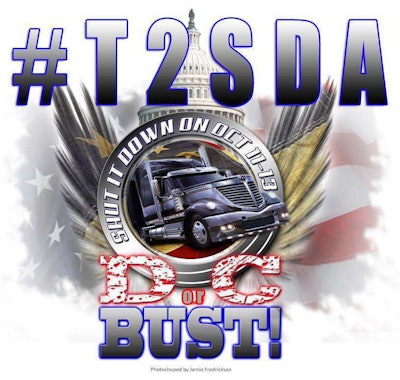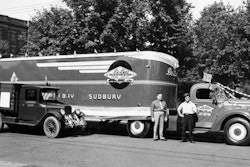The Ride for the Constitution fiasco of last weekend brings to mind the quote often associated with war reporting: “The first casualty when war comes is truth.” That’s California Sen. Hiram W. Johnson, addressing the U.S. Senate in 1917.
Truth was also a casualty in the free-for-all publicity surrounding the planned trucker mega-protest that peaked at about 30 trucks.
Consider this Fox News headline, posted Thursday afternoon, when it was obvious that the next day’s event lacked any widespread support: “Watch Out D.C.: Thousands of ‘Fed Up’ Truckers Are on Their Way.” And its lead sentence, an unattributed brash falsehood: “Some 10,000 truckers are on their way to Washington to gather peacefully this weekend …” Other news outlets were less gullible, though many stories failed to question the organizers’ wildly divergent predictions.
 This hashtag (truckers to shut down America) was used to spread the word on the Ride for the Constitution.
This hashtag (truckers to shut down America) was used to spread the word on the Ride for the Constitution.Such unprofessional reporting, as well as the social media-inspired buzz that led up to the non-event, show the good, the bad and the ugly of how the Internet has changed news reporting.
It’s no secret that news has moved away from the official filters – professional gatherers and producers – and far more into the hands of the audience. The change started before social media ascended, but now it’s wide open.
Most people find the amazing diversity of media channels and voices refreshing. Even many ink-stained newspaper guys, like me, do. Though that’s not to say it’s been a bloodless revolution.
In older days, truckers would complain over the CB or in a letter to the editor of Overdrive about how they should shut down. They’d show America a thing or two when the grocery shelves are empty.
In rare cases (1979, 1983, 1993), there was enough focus (fuel prices, fuel taxes) and momentum to stage partial shutdowns that merited notice. Otherwise, shutdown talk went nowhere.
Now it’s easier to gain traction. A “Truckers to Shutdown America” Facebook page helped launch last weekend’s demonstration, following television commentator Glenn Beck’s mention of it on one of his broadcasts. The Ride for the Constitution.org website also helped.
Multiply these by thousands of Facebook, twitter and blog posts, as well as sharing via email, text, etc., and it’s easy to see why the talk evolved into stories not only in trucking outlets, but also mainstream national consumer media.
Were organizers prepared for such exposure? No. There was no one designated spokesperson, at first no clearly defined trucking issues, and ridiculous, often vague non-trucking issues. One organizer, Earl Conlon, admitted his extremist remarks were lies intended to spark interest. It was more than a stretch to take the movement seriously.
One of my newspaper newsroom mentors often said, “Any fool can say something. That doesn’t mean you have to print it.” Still sage advice, though the new reality is that the fool can self-publish, and there are no shortage of willing fools to magnify foolishness.
That puts a bigger responsibility on the audience to separate the wheat from the chaff. It also puts more responsibility on those of us who have some role in continuing to filter and refine information that serves a particular audience.
In the case of the Ride for the Constitution, Overdrive chose to cover it closely because it was clear that our readers were very interested in it, even if they had no intention of participating. We tried to present all sides and let readers reach their own conclusions.
I’d like to hear your thoughts about the protest and how we reported it.








